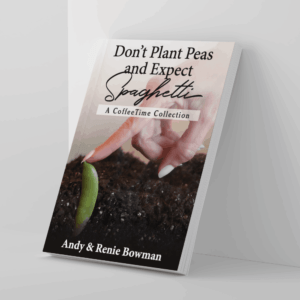Several years ago, Andy developed a “hitch-in-his-get-along” as his Mom used to call it.
Back when he was playing racquetball on a regular basis, while competing in a heated game he had run full speed into the concrete sidewall with his shoulder. Weeks later, the pain from that close encounter still hadn’t left and finally drove him to his doctor.
The doctor’s examination involved the necessary moving and rotating of Andy’s arm to find out exactly what had happened internally. As Doc would lift the arm, Andy would grimace with the pain.
To which the doctor would ask, “Does that hurt when I lift it?”
“You better believe it.”
“Then don’t do that.”
The same exchange would happen again and again as the good doctor examined, probed, lifted, and pushed. Finally he told Andy that his shoulder had been severely sprained. He needed to refrain from causing any more damage by not doing anything that caused him pain. In fact, it would benefit from not being used for a while. Just let it rest so it could heal.
Andy left that day with a clear understanding – if he did something that caused his shoulder to hurt, DON’T DO THAT.
Years passed, and that story became part of his counseling arsenal. As he watched pain-filled married couples enter his office seeking counseling, he found himself referring back to those days of shoulder trauma. Back to his doctor telling him, “If what you are doing causes pain in that shoulder, you need to stop doing it. It can, and probably will, create more serious or permanent damage than you’ve already done.”
So he would tell the story to hurting couples and then add, “If it is hurting your w-h-a-t-e-v-e-r, you need to stop doing that. Long-term damage can result, if you persist in a behavior that is hurtful. Insert the words ‘your marriage’ in place of ‘that shoulder.’”
Other times, frustrated and concerned parents would bring in young Johnny or Susie, asking for help with their troubling behavior. Knowing that childhood helps define coming adulthood, they sincerely wanted help. He would tell them that there had to be a trauma somewhere. And it needed to be uncovered and stopped in its tracks, so healing can begin.
This needs to be heard – loud and clear; If something is happening that is causing pain, it needs to be stopped before it can create more serious or permanent damage.
Like his doctor said, STOP IT.”
Find the problem, stop what is irritating it, and allow healing to begin.


 We are Dr. Andy & Renie Bowman, authors of the nationally syndicated "CoffeeTime Column" and hosts of popular podcast "CoffeeTime with Andy & Renie Bowman".
We are Dr. Andy & Renie Bowman, authors of the nationally syndicated "CoffeeTime Column" and hosts of popular podcast "CoffeeTime with Andy & Renie Bowman". 